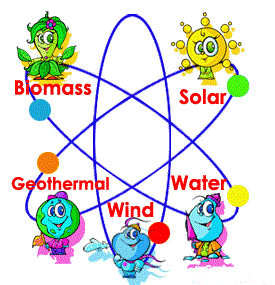Wednesday, July 28, 2010
Saturday, July 24, 2010
Advantages of Photovoltaic Generation
* There is no moving part so that little maintenance is required.
* They utilize an infinitely renewable and pollution free power source.
* The cells are reliable and long lasting with no harmful waste products.
* The cells are usually made of silicon which is one of earth’s most abundant and cheap materials.
* They have high power-to-weight ratio which is required in aerospace applications .
* They utilize an infinitely renewable and pollution free power source.
* The cells are reliable and long lasting with no harmful waste products.
* The cells are usually made of silicon which is one of earth’s most abundant and cheap materials.
* They have high power-to-weight ratio which is required in aerospace applications .
Energy from the Sun
Around 174 petawatts of solar radition is recieved by earth at the upper atmosphere Approximately 30% is reflected back to space while the rest is absorbed by clouds, oceans and land masses. The spectrum of solar light at the Earth's surface is mostly spread across the visible and near-infrared ranges with a small part in the near-ultraviolet.
Earth's land surface, oceans and atmosphere absorb solar radiation, and this raises their temperature. Warm air containing evaporated water from the oceans rises, causing atmospheric circulation or convection. When the air reaches a high altitude, where the temperature is low, water vapor condenses into clouds, which rain onto the Earth's surface, completing the water cycle. The latent heat of water condensation amplifies convection, producing atmospheric phenomena such as wind, cyclones and anti-cyclones. Sunlight absorbed by the oceans and land masses keeps the surface at an average temperature of 14 °C. By photosynthesis green plants convert solar energy into chemical energy, which produces food, wood and the biomass from which fossil fuels are derived.
Genaration of Electricity through Solar Energy
Solar energy, radiant light and heat from the sun, has been harnessed by humans since ancient times using a range of ever-evolving technologies. Solar radiation, along with secondary solar-powered resources such as wind and wave power, hydroelectricity and biomass, account for most of the available renewable energy on earth. Only a minuscule fraction of the available solar energy is used.
Solar powered electrical generation relies on heat engines and photovoltaics. Solar energy's uses are limited only by human ingenuity. A partial list of solar applications includes space heating and cooling through solar architecture, potable water via distillation and disinfection, daylighting, solar hot water, solar cooking, and high temperature process heat for industrial purposes.To harvest the solar energy, the most common way is to use solar panels.
Solar technologies are broadly characterized as either passive solar or active solar depending on the way they capture, convert and distribute solar energy. Active solar techniques include the use of photovoltaic panels and solar thermal collectors to harness the energy. Passive solar techniques include orienting a building to the Sun, selecting materials with favorable thermal mass or light dispersing properties, and designing spaces that naturally circulate air.
Tuesday, July 20, 2010
Renewable Energy Resources
The sources which can be reused to generate energy or electricity is commonly known as renewable energy sources. These sources include solar energy, wind energy, tidal energy, hydral power, energy from biomass and geothermal energy. Below is the chart given for the renewable energy sources in UK.
Renewable energy resources used in UK between 1990 and 1998, and the equivalent amount of oil.
Renewable energy resources used in UK between 1990 and 1998, and the equivalent amount of oil.
| Renewable energy resources | Equivalent amount in oil (thousands of tonnes) | |||
| 1990 | 1996 | 1997 | 1998 | |
| Active solar heating | 6.4 | 8.6 | 9.0 | 9.5 |
| Onshore wind | 0.8 | 41.8 | 57.2 | 76.1 |
| Hydroelectric | 447.7 | 289.0 | 354.8 | 449.3 |
| Landfill gas | 79.8 | 247.2 | 316.0 | 400.8 |
| Sewage sludge digestion | 138.2 | 190.2 | 191.5 | 184.1 |
| Wood | 174.1 | 709.7 | 710.3 | 710.3 |
| Straw | 71.7 | 71.7 | 71.7 | 71.7 |
| Municipal solid waste | 160.0 | 368.7 | 427.0 | 567.7 |
| Other biofuels | 80.6 | 175.7 | 182.1 | 185.5 |
| Total | 1,159.3 | 2,102.6 | 2,319.6 | 2,655.0 |
Subscribe to:
Posts (Atom)

